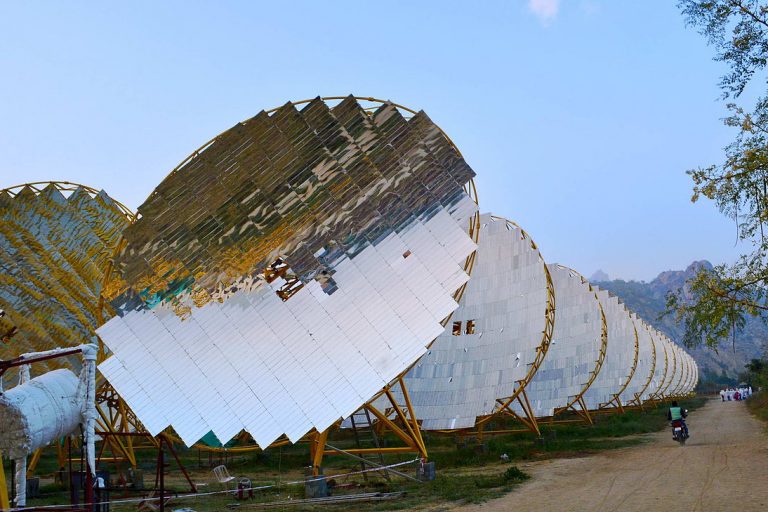- In the past, and under Pres. Trump and Prime Minister Modi, the U.S. and India have often been at odds environmentally, especially regarding climate change, with the U.S. saying that developing nations need to do more to cut emissions, while India says that the U.S, as biggest historical carbon emitter, must take a primary role.
- However, the two countries, under Obama and now under Trump, have quietly done trade agreements to enhance the transfer of liquid natural gas and nuclear power plant technology via sales from U.S. high tech companies to India.
- India’s Modi, a proponent of solar energy, was also convinced in talks with Pres. Obama to be a big supporter of the Paris Climate Agreement. Though, with the ascendance of Pres. Trump, and his rejection of the landmark accord, the two countries have again parted ways.
- Trump’s plan to renege on a US $2 billion Green Climate Fund (GCF) commitment made by Pres. Obama could somewhat slow India’s drive to quickly embrace green technologies.
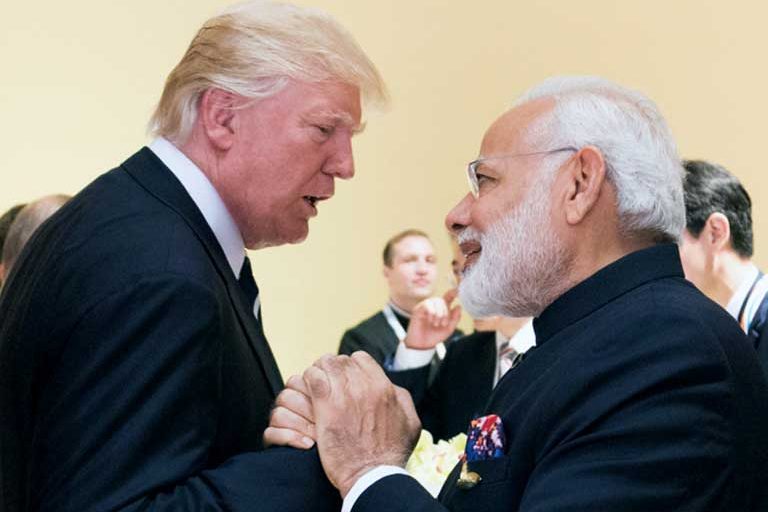
President Trump and Prime Minister Modi talk at the G20 summit in Germany this summer. Photo courtesy of the White House
India and the United States have traditionally not seen eye-to-eye on climate change and energy policies. Since the Kyoto Protocol negotiations of the 1990s, diplomats of the two nations have fought many a fierce battle in air-conditioned rooms during international summits arguing over emission cuts and their cost to both economies. And they haven’t come away with much to show for their work.
Recent political events have done little to reveal any new common ground between two of the world’s largest democracies, and carbon polluters.
Two days before President Donald Trump announced that the U.S. would pull out of the Paris agreement, Indian Prime Minister Narendra Modi warned him that “playing with the wellbeing of future generations would be an immoral and criminal act,” emphasizing the need for the world’s nations — including the U.S. — to strive towards protecting the planetary environment.
On the 1st of June, President Trump showed that, to his mind, calls to morality and shared responsibility, did not hold water: “The bottom line is that the Paris Accord is very unfair at the highest level to the United States,” said Trump in his White House Rose Garden speech. “India will be allowed to double its coal production by 2020. Think of it. India can double their coal production. We’re supposed to get rid of ours!”
In essence, not a lot has changed diplomatically between India and the U.S. since the years leading up to Kyoto: India believes the U.S. should shoulder more responsibility, as it is the highest historic contributor to carbon emissions, and the second highest emitter now, after China. But the U.S. holds that developing countries, especially those with large populations, like India and China are shirking their obligation to cut emissions while gaining huge economic advantage.

Smog near Delhi. India suffers from severe air pollution due to its past commitment to coal burning power plants. Public outrage over severe urban smog has helped push India’s leaders toward clean energy solutions. Photo by Saurabh Kumar licensed under the Creative Commons Attribution-Share Alike 4.0 International license
Regardless of the high level rift, observers have long hoped that bipartisan solutions to climate change would eventually emerge from market forces and greater awareness of global warming risk. The sharply falling price of renewables, for example, coupled with an understanding by businesses and the public in both nations could eventually bring cooperation to reduce emissions.
“Renewable energy becoming affordable is the game changer,” said Chandra Bhushan, Deputy Director General of the Centre for Science and Environment, a New Delhi based research and advocacy organization. “The market is doing what endless discussions of world leaders cannot easily achieve.”
In reality — even though the rhetoric of Trump and Modi seems worlds apart — the international energy trade is bringing the two countries together. Put simply, India possesses a huge potential market and need for clean energy technologies, an that’s a need which U.S. tech companies would love to fill.
India’s Carbon Reduction Challenge
Of India’s more than 1.2 billion citizens, more than 360 million live in poverty. That population is projected to grow to 1.45 billion by 2028, surpassing China’s, with India becoming the world’s most populous country. As that population grows, and also hopefully prospers, energy demands will soar.
India’s challenge: maintain high levels of economic growth despite the burgeoning population by increasingly reducing its carbon footprint. Keeping that goal in mind, the country unveiled its long-range climate change plan in October 2015, pledging to source 40 percent of its electricity from renewable and other low-carbon sources by 2030 — a tall order for a nation in the developing world.
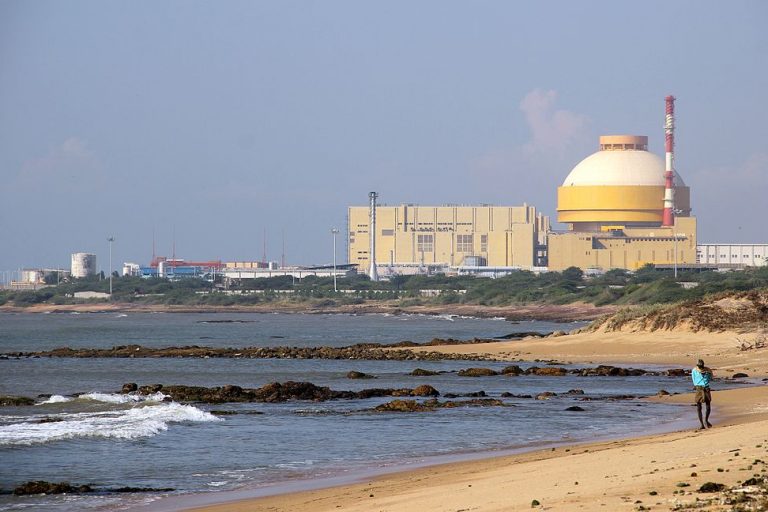
The Kudankulam nuclear power plant, currently India’s largest was built with Russian cooperation, and became operational in 2013. Even as U.S, nuclear plant construction stalled this year, India sanctioned ten new nuclear plants, with an estimated generating capacity of 7000 megawatts (MW). U.S. companies hope to profit from some of this new construction. Photo courtesy of indiawaterportal.org licensed under the Creative Commons Attribution-Share Alike 2.0 Generic license.
One way to achieve those ambitious targets is by relying on cleaner energy sources like natural gas and nuclear energy. But that means tapping into the international community’s clean energy entrepreneurs and their first world technologies. And that means global partnerships that include the United States.
One example: Gas Authority India Limited (GAIL), the largest state-owned natural gas processing and distribution company in India, is currently contracted to purchase 5.8 million metric tons per year (MMTPA) of liquefied natural gas (LNG) from a US terminal. However, the approved price of the gas could be higher than what India could get from West Asia or Africa. However, analysts say U.S. gas suppliers are very likely to renegotiate price because India is a very important potential LNG market.
As a result, President Trump, even as he loudly proclaims a rebirth of U.S. coal, has also pushed for long-term contracts with India to purchase American natural gas.
By 2020, India will potentially be importing 50 MMTPA of natural gas. “If the price were right, in principle there would be a lot of scope for additional gas imports [to India]. Almost up to 88 percent of projected net natural gas exports from the United States,” revealed Arunabha Ghosh, CEO for the Council on Energy, Environment and Water. “There is [potential for] a broader scope in bilateral energy partnership [between India and the U.S.], especially when we count in nuclear technologies.”
In 2008, during the Bush administration, the two countries signed a civil nuclear agreement, ending India’s nuclear isolation, and allowing civil nuclear trade with New Delhi. This is seen as a huge market opportunity for the U.S. nuclear energy industry, and just in time. Even as U.S, nuclear plant construction stalled this year, India sanctioned ten new nuclear plants, with an estimated generating capacity of 7000 megawatts (MW).
While many environmentalists will argue that neither nuclear or natural gas represent the best alternative energy way forward for India, such cooperative international agreements certainly represent a definite move away from both coal and oil.
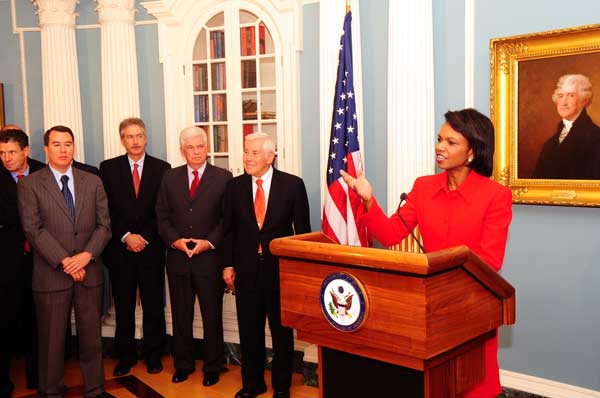
U.S. Secretary of State Condoleezza Rice in India to conclude the 2008 Agreement on Peaceful Use of Nuclear Energy. Photo by Michael Gross / U.S. State Department
Past energy cooperation between India and the U.S.
The initiation of cooperation between India and the U.S. to create clean energy solutions certainly cannot be credited to President Trump. Since Prime Minister Modi took office in May 2014, he has made five official visits to the U.S., with four of them occurring during the Obama years. Only one visit, which showed little in the way of outward policy advances, came under Trump.
Amidst all the awkward hugging and handshaking, Modi and Obama made immense progress on the clean energy front during their meetings. Modi’s state visit to Washington in September 2014 was soon reciprocated by Obama’s in January 2015 on occasion of India’s Republic Day. In a joint press conference then, Modi notably changed his stance on climate change by agreeing that India too had to reduce emissions for the sake of its own population. It was a significant move away from his entrenched “developed countries must do more” line.
When President Trump took over, observers were unsure of what to expect. But true to his campaign promise, the new administration withdrew from the Paris Climate Agreement. India, the world’s fourth-largest carbon emitter, ratified the Paris Agreement in October 2016, becoming the 62nd nation to do so. Now, with Nicaragua’s joining the agreement, only Syria and the U.S. stand outside.
Under the Accord, most developing nations agreed to cut emissions in return for financial support, technology transfer and capacity building from the developed countries. According to some estimates, the sum total of such needed support would be an estimated $2-$4 trillion.
To meet its voluntary emissions reductions under the Paris Agreement, India will have to shift significantly from coal-based generation to renewable energy sources. According to one source, it will need to ultimately produce 100 gigawatts (GW) from solar, 60 GW from wind, 10 GW from biomass and 5 GW from small hydropower by 2022. To make that shift, it will need significant international assistance. But for now, little of that help will be coming from the United States.
U.S. withdrawal from the Paris Agreement could have immediate effects on the creation of a clean energy industry in India. President Obama had promised US$3 billion (out of $10.13 billion pledged by 43 nations) to the Green Climate Fund, an entity under the United Nations Framework Convention on Climate Change.
In April, the fund announced US$34 million for solar micro-irrigation and watershed management projects in the eastern Indian state of Odisha. But since President Trump’s publicized plan for a complete withdrawal from the Green Climate Fund (reneging on $2 billion out of Obama’s $3 billion promised total), the future of those projects looks unsure, according to the National Bank for Agricultural and Rural Development, which is handling the Indian projects.
Who will fund such projects now? Most observers feel that the financial responsibility should be shouldered by other developed countries. “China and India do not have historical responsibility, [for the bulk of past emissions], writes Indrajit Bose of the Third World Network, “So, making [China and India] fill the gap will disrupt the delicate balance of differentiated responsibilities of developed and developing countries achieved in the [Paris] agreement. In fact, they are already doing more than their fair share of climate action. The only way to ensure equitable climate action is that developed countries step in and fill the gap left by the U.S.”
Most Indian experts, however, aren’t overly worried by the $2 billion GCF loss represented by Trump’s reversal. They feel that this amount is too little to seriously affect the larger strides that India is making to usher in a clean energy economy.

Prime Mininster Narendra Modi with US President Barack Obama. The two men met four times and found common ground in their talks regarding climate change and carbon emissions. Photo by VinyS licensed under the Creative Commons Attribution-Share Alike 4.0 International license
Pressure on India to act on climate
Even before the Paris Summit in December 2015, India had pledged to reduce its carbon intensity by 35 percent by 2030 and to develop 175 GW of renewable energy capacity by 2022.
In line with that, India’s Environment Ministry commissioned research this summer on decoupling greenhouse gas emissions from economic growth. The Energy Research Institute, Observer Research Foundation and Centre for Study of Science, Technology and Policy have been asked to recommend future low carbon growth scenarios for the country. If they stick to schedule, these organizations can present their findings to the Ministry even before the implementation of the Paris Agreement begins in 2020.
“These changes are happening not because of political will, but despite it,” said Srinivas Krishnaswamy, Chief Executive Officer of the Vasudha Foundation, an organization actively involved in climate negotiations occurring under the aegis of the United Nations Framework Convention on Climate Change (UNFCCC). “Climate change was never an election issue in India,” he explained. “We still fight elections on the basis of economy, jobs and caste,” he said.
That’s one reason why, when Trump met Modi in June, talks hovered around visas and other strategic issues. “PM Modi knows better than to talk to President Trump about [the] environment,” said Krishnaswamy. “H1B1 will bring in election funding and votes, not climate change talks,” he added, referring to the U.S. visas for IT professionals.
However, in the past few years, since air pollution in Delhi has made headlines throughout the world, the government has found itself under pressure to act. And it has taken baby steps in the direction of clean energy.
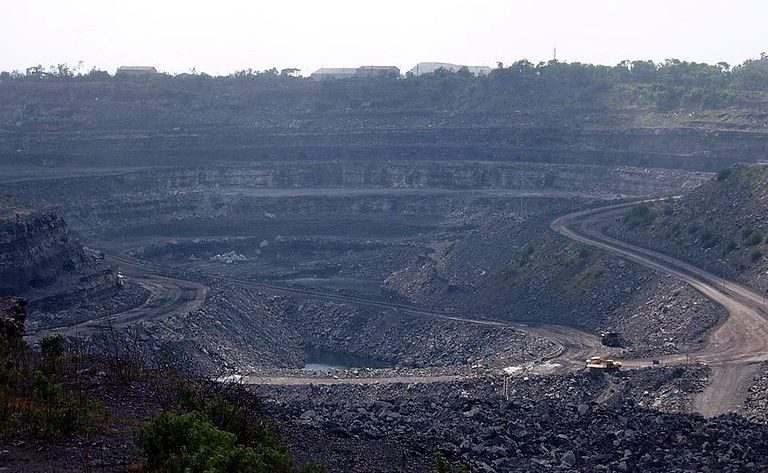
Coal mine in Dhanbad, India. While India has a good supply of coal, air pollution produced by coal-burning power plants has caused the country to move away from this dirty source of energy. Photo found on flickr licensed under the Creative Commons Attribution 2.0 Generic license
India has, for example, abandoned its previous commitment to coal. Instead of building coal-fired power plants, it is now canceling many that were planned. In May, the government lowered its annual coal production target from 660 million tons to 600 million tons. The country has also committed to only sell electric cars by 2030.
Another boost to India’s efforts to reduce carbon emissions has been Modi’s sustained interest in renewables. As chief minister of Gujarat state for three terms, he instituted more than 900 MW of solar power across the region. Since India receives more sunlight than any other G-20 country, he has expressed a desire to push solar across the nation.
In regard to its greenhouse gas emissions and policies implemented to curb them, the Climate Action Tracker has rated India as a country “compatible” with its stated Paris Agreement goals. While, Turkey, Saudi Arabia and the United States are rated “critically insufficient.” However, a lot more needs to be done if India is to achieve its Paris commitments.
Bhushan noted that it will be tough for developing countries to keep up with their twin goals of economic development and carbon emissions reduction without U.S. financial backing. He added that, “since the rules are being framed right now for the Paris Agreement, countries of the world should get together to discuss how to reprimand the U.S.” Such discussions might occur at the Bonn climate summit this November.
Global warming is now a matter of concern around the world. And at the heart of that concern lies the question of how to drastically curb energy emissions without stalling economic growth and prosperity, especially in the developing world. Rhetoric aside, neither the U.S. under Trump or India under Modi have yet taken the huge practical steps required to meet this daunting challenge. Immense supplies of political will, international cooperation, and money will be needed to speed up the effort exponentially in order to avoid potentially catastrophic climate change.
Published in: Mongabay
Published on: 3 October, 2017
Link: https://news.mongabay.com/2017/10/even-as-trump-and-modi-clash-on-energy-india-and-u-s-are-partnering/


